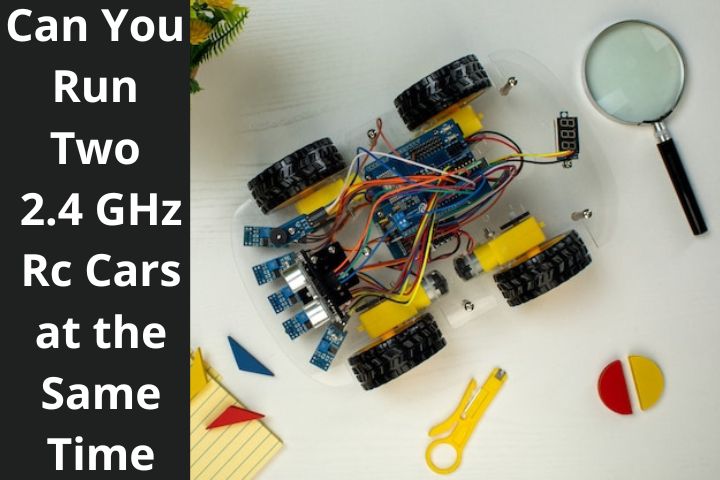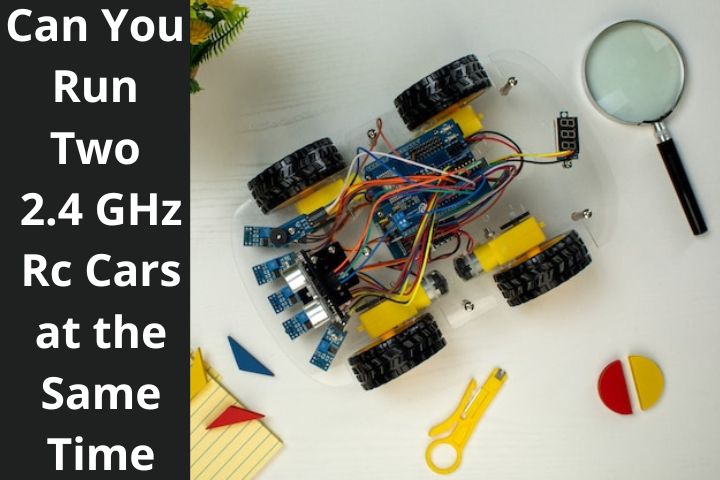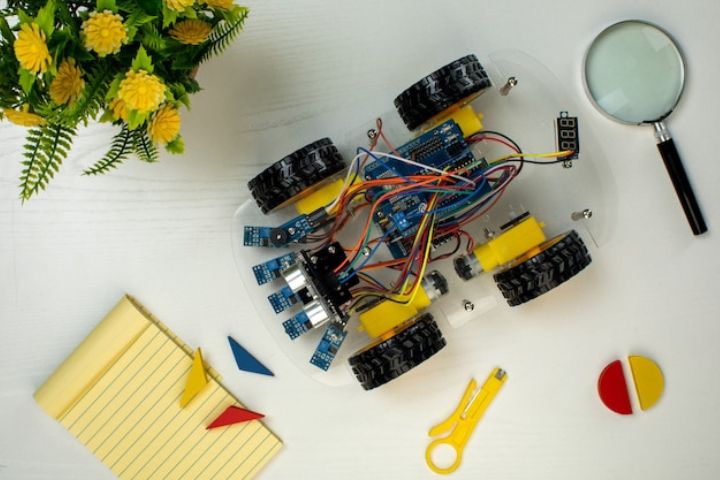
Can You Run Two 2.4 GHz Rc Cars at the Same Time? The thrill of running two 2.4 GHz radio control (RC) cars side-by-side at maximum speed is a sensation that truly must be experienced to be appreciated. Not only do the cars reach top speeds of 30 mph with ease, but they also can make sharp turns and drift around corners without losing their balance. With large enough open areas, maneuvers such as spins and jumps can be achieved when running two cars at the same time, providing a unique challenge for both beginners and experienced RC racing fans alike. All it takes to gear up for the race is one 2.4 GHz controller per car, and you’re ready to go!
Can You Run Two 2.4 GHz RC Cars at the Same Time
It is possible to operate two 2.4 GHz remote control cars simultaneously; however, there are a few considerations that need to be taken into account.
Numerous electronic gadgets, including Wi-Fi routers, Bluetooth devices, and microwave ovens, all operate on the same standard frequency of 2.4 gigahertz (GHz). Because of this, there is a possibility of signal interference between the remote control and the vehicle, which may result in the vehicle behaving unpredictably or not responding at all.
In addition, the majority of 2.4 GHz remote control systems employ a method known as frequency hopping to prevent their signals from interfering with those of other devices. Two cars can cause interference with each other if they both use the same frequency-hopping pattern.
If you want to minimize interference when running two 2.4 GHz RC cars at the same time, you may need to use distinct channels or bands. Some remote control systems include several channels from which the user can choose, while others may make use of distinct bands within the 2.4 GHz frequency spectrum.
It is also important to note that some manufacturers may have specific instructions on how to run multiple cars at the same time. As a result, it is always a good idea to check the product documentation or contact the manufacturer for guidance. In addition, it is also important to note that some manufacturers may have specific instructions on how to run multiple cars at the same time.
How to Run Two 2.4 GHz RC Cars at the Same Time
There are a number of different approaches to running two remote-controlled 2.4 GHz cars at the same time, including the following:
• Change the channel: Many remote control systems that operate on the 2.4 GHz frequency band have various channels from which to choose. The vehicles can function on multiple frequencies and avoid interfering with one another when they use distinct channels to communicate.
• Utilize different bands: Different bands of the 2.4 GHz spectrum are utilized by certain remote control systems. This is done in order to reduce the likelihood of interference occurring.
• Make use of a variety of frequency-hopping patterns: To prevent remote controls from interfering with the operation of other devices, certain 2.4 GHz remote control systems employ a method known as frequency hopping. Two cars can cause interference with each other if they both use the same frequency-hopping pattern. By utilizing a variety of frequency-hopping patterns, it is possible to assist in avoiding this problem.
• Utilize a frequency band that has been set aside expressly for the use of remote controls: Certain nations have set aside particular frequency bands for the use of remote controls, such as the 75 MHz band in the United States or the 35 MHz bands in Europe. Using one of these bands can assist in preventing interference from being caused by other electronic devices.
It is usually a good idea to examine the product paperwork or contact the manufacturer for help while operating many cars at the same time. Some manufacturers may have special instructions, so it is best to check the documentation or get in touch with the manufacturer.
Issues with Radio Controlled Cars and the Same Frequency
When employing radio-controlled cars on the same frequency, there is the potential for several problems, including the following:
• Interference: If two or more cars are using the same frequency, their signals can interfere with each other and cause the cars to act strangely or not respond at all. If this happens, the cars will not be able to communicate with each other.
• Loss of Signal: If two or more cars are using the same frequency, the signal can get weaker, which might cause the cars to lose control or cease working entirely.
• Control Confusion: If two or more cars are utilizing the same frequency, the remote control signals may become jumbled, leading the cars to respond to the wrong remote control. This can happen when two or more cars use the same frequency.
• Overheating: Because of the interference caused by radio waves, the electronic components of the vehicles may experience overheating.
• Drain on the Battery the electrical components may consume more power to eliminate the interference, which will result in the batteries draining more quickly.
When operating numerous radio-controlled automobiles at the same time, it is imperative to make use of various channels or bands, as well as various frequency-hopping patterns, to prevent problems like these from occurring. As was previously said, some manufacturers may have special instructions on how to run many automobiles at the same time; hence, it is always a good idea to examine the product documentation or contact the manufacturer for direction.
How to Avoid Radio Frequency Interference in RC Cars?
Try to Avoid Approaching Other Rc Cars Closely
RC cars can be a lot of fun to play with, but if you’re not careful, another car’s radio frequency can interfere with yours. Avoiding approaching other RC cars too closely is the best way to ensure that your car works properly and you don’t experience interference. It’s important to keep your distance when it comes to your fellow RC car owners so as not to get frustrated by malfunctions and slow responses. When in doubt, err on the side of caution and stay away from other cars.
Many different types of cars can race on the 2.4GHz frequency without interfering with one another because of the wide range of frequencies available. Cross-talk with another racer is possible even with a 2.4GHz spectrum radio, so if it happens to you, it’s best to keep your distance.
This is especially problematic in the toy industry, as radios commonly operate between 27MHz and 49MHz on the MHz band. The maximum allowed distance inside the MHz range is around 100 ft. To avoid a signal blockage, you need to go 200 feet down the roadway.
Selecting Different Frequencies
When looking for the right frequency for your RC cars, it’s important to avoid radio frequency interference. This can be a tricky task, as other nearby vehicles may be using the same model with the same frequency. It’s best to have multiple RC cars with different frequencies to prevent potential interference issues. You may even need to search many areas of your local hobby store to locate channels outside of a particular spectrum. Avoiding Radio Frequency Interference takes extra time and research but is essential in ensuring that your RC vehicles will operate at their fullest potential.
Due to their reliance on radio waves for propulsion, radio-controlled vehicles are limited in the range of frequencies they may employ. Intersections are not common, yet they are not impossible. Again, GHz spectrum radios have it much easier because there are thousands of frequencies available and the likelihood of duplication is vanishingly small. Unfortunately, most children’s toys fall within one of two frequency categories: 27MHz or 49MHz. Consequently, if you plan on using both units simultaneously, you should avoid purchasing them at the same frequency.
Also read: How to Change Frequency on Remote Control Car
Pick RC Vehicles with Selectable Band Frequencies
When shopping for RC vehicles, it’s important to consider packable band frequencies to help avoid radio frequency interference. By ensuring your RC vehicle operates on different frequencies, other users in the same area won’t interfere with your car’s controlling mechanisms and wireless signals, leading to smoother operation and uninterrupted fun. With so many models out there, making sure you find one that comes with selectable bands is essential when selecting the right RC toy for you or your loved ones.
Most inexpensive RC cars cannot be altered or changed to a different frequency to get away from another vehicle. In theory, a radio-controlled vehicle operating at 27MHz would use Channel 4, which is located at 27.145MHz.
If the documentation for these lower-frequency cars mentions the phrase “band selectable,” then the vehicle likely has a mechanism to switch between different frequency bands. You can tell if a set of cars can play together despite a slight difference in frequency by looking for the line “may be playable with up to xx more cars” on the box.
Protecting Hobby-Grade Vehicles from Interference
Protecting hobby-grade vehicles from interference is an important part of making sure they operate safely and effectively. One good way to do this is to avoid radio frequency interference in RC Cars. There are special products available that shield against outside frequency noise, like external antennas and filters, to help keep the signal clean between your car and its controller. Furthermore, simply making sure that there are no other wireless devices in the range of your vehicle will also help reduce the chances of outside interference. With these precautions taken properly, you can rest assured that your vehicle will run smoothly and without incident.
Now we can see the first major distinctions between a toy RC car and a hobby RC car. Hobby-grade RCs are very customizable, unlike their toy counterparts; swapping out the radio for a different signal is a realistic option. As a result of their adaptability, hobby cars are rarely cheap and can easily cost several thousand dollars. Other options, such as swapping out the crystals themselves, may be available in addition to the ones already stated.
Rc Car Frequency Adjustment
Some problems have simple solutions, like the one we just examined, while others require well-designed model cars.
What are the options for adjusting the radio frequency of an RC vehicle? More advanced tweaking of the frequency that transmits the signal to the car is possible with the more pricey hobby-level vehicles.
It is possible to change the frequency of RC cars by adjusting the crystal. In most cases, additional crystal sets can be found in RC accessory shops. After that, the car’s frequency can be changed by switching the crystals in the receiver and the remote.
With a simple frequency swap, you can operate two separate RC vehicles at once. Since this isn’t possible on all RC vehicles, you should check the market carefully before making a purchase.
The 27MHz and 49MHz ranges (also used for micro RC vehicles) each have six channels, the 50MHz range has ten channels, and there are many more options for hobby-level vehicles (requiring a radio license).
In addition, the United States makes available 30 channels in the 75MHz band for hobby-grade RC vehicles.
The Various Frequencies for Rc Cars
RC cars come in a variety of shapes and sizes, but one thing that every driver should be aware of is the various frequencies available when purchasing a new car. Each RC car operates on a specific frequency, so it’s important to have compatible frequencies if multiple drivers plan on racing together. Depending on the type of car, the frequency can range anywhere from 27 MHz to 2.4 GHz. Not only do different frequencies permit multiple users to play at the same time, but they also affect select car features like speed, acceleration, and braking power. It is important to note that some frequencies are only allowed in certain regions or countries. Therefore, researching local rules and regulations is essential before making any purchase.
Conclusion
Visiting the local park on a sunny day with two 2.4 GHz RC cars running side-by-side can be an absolute blast. Controlling one car while your friend, sibling, or parent helms the other leads to exciting races, stunts, and other fun activities. To get the most out of these two remote control wonders, make sure that they use compatible frequencies so that there won’t be any interference between them. Otherwise, you might end up with one car increasing speed while the other becomes sluggish and unresponsive! But when both cars run perfectly in tandem, it’s a joy to watch them weave around obstacles like miniature Formula-1 drivers. So grab your radio controller and find someone to join you for some RC car fun.


